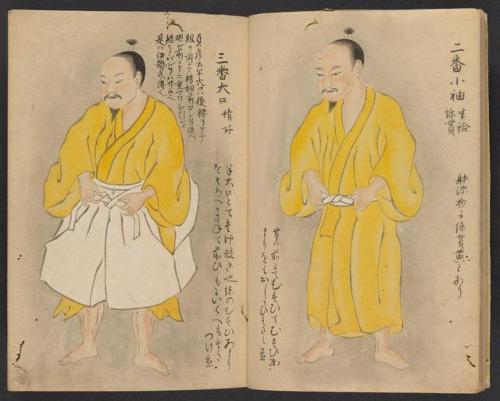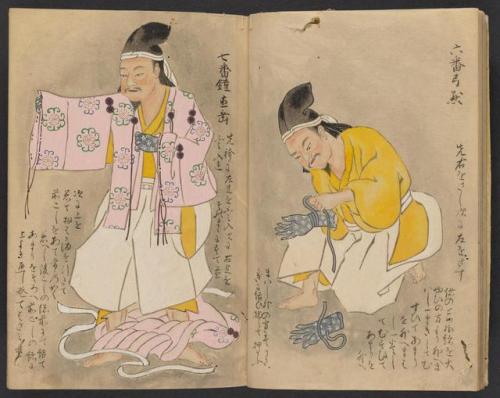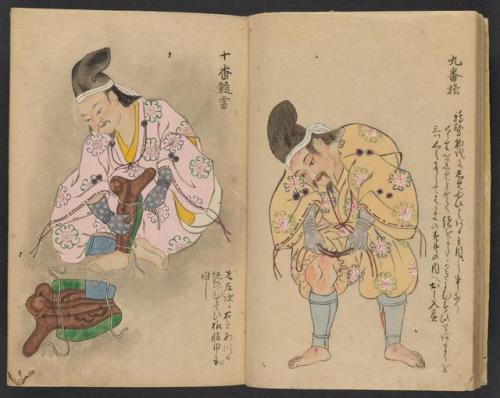Awesome Infographic Work By Designer Yang Liu. Check Out Her Book ’East Meets West’ (Amazon).






Awesome infographic work by designer Yang Liu. Check out her book ’East Meets West’ (Amazon).
More Posts from Philosophical-amoeba and Others






Dress for the job you want.
Yoshiie Ason yoroi chakuyōzu 義家朝臣鎧着用次第 by Sadatake Ise is a pictorial work on how to put on Japanese Samurai armor. The subject is famed Samurai warrior Minamoto No Yoshiie.
Find more amazing rare books we’ve recently digitized from our Freer | Sackler branch library in our book collection, Japanese Illustrated Books from the Edo and Meiji Period.

No. 2 Construction Battalion
Fighting for a country that didn’t want them.
On March 25 1917, Canada’s first and only black military unit left Halifax harbor for the Western Front. Six hundred soldiers, mostly from Nova Scotia, formed up as No. 2 Construction Battalion. Many had been trying to enlist since 1914, but winning this privilege had been an up-hill fight: for two years military authorities had turned down black recruits, telling them “This is a white man’s war.”
Finally, in 1916, Canada allowed black recruits entry into a segregated united of laborers. An additional 165 African-Americans crossed the border to join them, creating a full complement of 600 men. Winning the struggle to join up hardly ended discrimination. Except for the reverend, all officers were white, and even when they went to board their transport ship on March 25 the captain initially refused to let them on, saying that he would not let them travel on the same vessel as white soldiers.

The recruits hoped to be allowed to fight when they reached France, but instead the Canadian Expediotnary Force immediately downgraded them from a battalion to a company and assigned them to fell trees and prepare positions for white soldiers. They were not ever even issued with rifles. Their work was tedious and demoralizing, and many considered themselves failures even as they suffered casualties from artillery shells and poison gas.
The unit returned to Canada in 1919, but received no fanfare upon arrival. Much like America’s black soldiers, they returned to a country that did not value them or their sacrifice and actively oppressed their rights. Most of these veterans returned to poverty and unemployment. When they finally had their first reunion in 1982, only nine could attend from twenty known survivors. Their legacy and sacrifice has been revived since then. Although very few men were allowed the chance to serve, they began the first crack in the Canadian military’s institutionalized racism.


Samurai armour.
A chart I made showing the names of the various main components of a suit of “modern samurai armour” or tosei gusoku. Tosei gusoku refers to armour worn by samurai that began to appear during the middle of the Muromachi Period (1337-1573) with the introduction of firearms.
A full suit of tosei gusoku as shown in my chart would have weighed in at around 30 kilograms or so including weapons - there is after all a considerable amount of iron plates and lacing!
Lower class samurai such as foot soldiers (ashigaru) would have carried their own rations, bedding, and other equipment, but their armour was somewhat lighter being generally less ornamented.
At this point in time, known in Japanese history as the Sengoku Period or the Warring States Period, the most common samurai weapon was the spear followed by the bow and arrow. The sword at this point in time was a secondary weapon relied upon during close combat.
The sword carried during this period was the longer, gracefully curved tachi and was worn edge down on the left side supported either by it’s own tachi mounting (tachi koshirae) or by using a special leather “sling” (koshiate) if it was mounted without hangers (ashi).
Another shorter sword called a chisagatana - literally “little sword” - was carried together with the tachi at the left hip up until the Momoyama period (1573-1603) when it was abandoned. The chisagatana was originally a throw away weapon reserved for use by conscript foot soldiers (ashigaru), but higher ranking samurai soon took up the carrying of one as a back up weapon.
Higher ranked samurai, those in charge of troops and generals in particular, also carried a short stout blade called a metezashi at the right hip, with the handle facing forwards. This weapon was designed for extreme close combat and used to penetrate the weak spots in an opponents armour. When swords were crossed, the metezashi could be drawn with the left hand and thrust into the opponent’s armpits. It could also be drawn with the right hand and thrown underarm in an instant to distract and stun an opponent before following up with the sword.
© James Kemlo


Pacific Lamprey (Entosphenus tridentatus)
Lampreys in their mature stage are parasites, latching onto other fish with their suction cup like mouths. Keratinised teeth rasp away their host’s skin, as the lamprey releases anticoagulants to ensure a steady supply of blood. Many victims die of infections or blood loss.
Dave Herasimtschuk and Jeremy Monroe
Don’t play, play - Singlish is studied around the globe
Blogger Wendy Cheng’s Web video series Xiaxue’s Guide To Life and Jack Neo’s Ah Boys To Men film franchise are well-known shows among Singaporeans. For one thing, they are filled with colloquial terms, local references and copious doses of Singlish terms such as “lah” and “lor”.
But they are not merely for entertainment. In recent years, such shows have found a place in universities around the world, where linguists draw on dialogues used in these local productions to introduce to undergraduates and postgraduate students how Singlish has become a unique variety of the English language.
This comes even as concerns have been raised over how Singlish could impede the use of standard English here.
From Italy and Germany to Japan, at least seven universities around the world have used Singlish as a case study in linguistics courses over the past decade. This is on top of more than 40 academics outside of Singapore - some of whom were previously based here - who have written books or papers on Singlish as part of their research.

Why do men have Adam's apples. It's so sexy but seems so unnecessary
It basically is unnecessary lol
It’s not that only men have Adam’s apples, women do too, but it’s less prominent. An Adam’s apple is just a piece of cartilage that protects your larynx (the voicebox) directly behind it. As boys & girls go through puberty, our voicebox grows which:
1. Causes our voice to deepen 2. Pushes the cartilage further forwards
In boys, the larynx grows in size significantly more which therefore pushes forward the evident bump of cartilage we like to call an Adam’s Apple.

Fructose alters hundreds of brain genes, which can lead to a wide range of diseases
A range of diseases — from diabetes to cardiovascular disease, and from Alzheimer’s disease to attention deficit hyperactivity disorder — are linked to changes to genes in the brain. A new study by UCLA life scientists has found that hundreds of those genes can be damaged by fructose, a sugar that’s common in the Western diet, in a way that could lead to those diseases.
However, the researchers discovered good news as well: An omega-3 fatty acid known as docosahexaenoic acid, or DHA, seems to reverse the harmful changes produced by fructose.
“DHA changes not just one or two genes; it seems to push the entire gene pattern back to normal, which is remarkable,” said Xia Yang, a senior author of the study and a UCLA assistant professor of integrative biology and physiology. “And we can see why it has such a powerful effect.”
DHA occurs naturally in the membranes of our brain cells, but not in a large enough quantity to help fight diseases.
“The brain and the body are deficient in the machinery to make DHA; it has to come through our diet,” said Fernando Gomez-Pinilla, a UCLA professor of neurosurgery and of integrative biology and physiology, and co-senior author of the paper.
DHA strengthens synapses in the brain and enhances learning and memory. It is abundant in wild salmon and, to a lesser extent, in other fish and fish oil, as well as walnuts, flaxseed, and fruits and vegetables, said Gomez-Pinilla, who also is a member of UCLA’s Brain Injury Research Center.
Americans get most of their fructose in foods that are sweetened with high-fructose corn syrup, an inexpensive liquid sweetener made from corn starch, and from sweetened drinks, syrups, honey and desserts. The Department of Agriculture estimates that Americans consumed an average of about 27 pounds of high-fructose corn syrup in 2014. Fructose is also found is in most baby food and in fruit, although the fiber in fruit substantially slows the body’s absorption of the sugar — and fruit contains other healthy components that protect the brain and body, Yang said.
To test the effects of fructose and DHA, the researchers trained rats to escape from a maze, and then randomly divided the animals into three groups. For the next six weeks, one group of rats drank water with an amount of fructose that would be roughly equivalent to a person drinking a liter of soda per day. The second group was given fructose water and a diet rich in DHA. The third received water without fructose and no DHA.
After the six weeks, the rats were put through the maze again. The animals that had been given only the fructose navigated the maze about half as fast than the rats that drank only water — indicating that the fructose diet had impaired their memory. The rats that had been given fructose and DHA, however, showed very similar results to those that only drank water — which strongly suggests that the DHA eliminated fructose’s harmful effects.
Other tests on the rats revealed more major differences: The rats receiving a high-fructose diet had much higher blood glucose, triglycerides and insulin levels than the other two groups. Those results are significant because in humans, elevated glucose, triglycerides and insulin are linked to obesity, diabetes and many other diseases.
The research team sequenced more than 20,000 genes in the rats’ brains, and identified more than 700 genes in the hypothalamus (the brain’s major metabolic control center) and more than 200 genes in the hippocampus (which helps regulate learning and memory) that were altered by the fructose. The altered genes they identified, the vast majority of which are comparable to genes in humans, are among those that interact to regulate metabolism, cell communication and inflammation. Among the conditions that can be caused by alterations to those genes are Parkinson’s disease, depression, bipolar disorder, and other brain diseases, said Yang, who also is a member of UCLA’s Institute for Quantitative and Computational Biosciences.
Of the 900 genes they identified, the researchers found that two in particular, called Bgn and Fmod, appear to be among the first genes in the brain that are affected by fructose. Once those genes are altered, they can set off a cascade effect that eventually alters hundreds of others, Yang said.
That could mean that Bgn and Fmod would be potential targets for new drugs to treat diseases that are caused by altered genes in the brain, she added.
The research also uncovered new details about the mechanism fructose uses to disrupt genes. The scientists found that fructose removes or adds a biochemical group to cytosine, one of the four nucleotides that make up DNA. (The others are adenine, thymine and guanine.) This type of modification plays a critical role in turning genes “on” or “off.”
The research is published online in EBioMedicine, a journal published jointly by Cell and The Lancet. It is the first genomics study of all the genes, pathways and gene networks affected by fructose consumption in the regions of the brain that control metabolism and brain function.
Previous research led by Gomez-Pinilla found that fructose damages communication between brain cells and increases toxic molecules in the brain; and that a long-term high-fructose diet diminishes the brain’s ability to learn and remember information.
“Food is like a pharmaceutical compound that affects the brain,” said Gomez-Pinilla. He recommends avoiding sugary soft drinks, cutting down on desserts and generally consuming less sugar and saturated fat.
Although DHA appears to be quite beneficial, Yang said it is not a magic bullet for curing diseases. Additional research will be needed to determine the extent of its ability to reverse damage to human genes.

How viruses infect bacteria: a tale of a tail
To infect bacteria, most bacteriophages employ a ‘tail’ that stabs and pierces the bacterium’s membrane to allow the virus’s genetic material to pass through. The most sophisticated tails consist of a contractile sheath surrounding a tube akin to a stretched coil spring at the nanoscale. When the virus attaches to the bacterial surface, the sheath contracts and drives the tube through it. All this is controlled by a million-atom baseplate structure at the end of the tail. EPFL scientists have now shown, in atomic detail, how the baseplate coordinates the virus’s attachment to a bacterium with the contraction of the tail’s sheath. The breakthrough has made the cover of Nature, and has important implications for science and medicine.
Nicholas M. I. Taylor, Nikolai S. Prokhorov, Ricardo C. Guerrero-Ferreira, Mikhail M. Shneider, Christopher Browning, Kenneth N. Goldie, Henning Stahlberg, Petr G. Leiman. Structure of the T4 baseplate and its function in triggering sheath contraction. Nature, 2016; 533 (7603): 346 DOI: 10.1038/nature17971
Bacteriophages are viruses that infect bacteria. Using state-of-the-art tools, EPFL scientists have described a million-atom “tail” that bacteriophages use to breach bacterial surfaces. The breakthrough has major implications for science and medicine, as bacteriophages are widely used in research.


In the days after the September 11 terrorist attacks, a number of spontaneous memorials appeared in the city. One, later named Tiles for America, displayed thousands of hand-painted tiles with inspirational messages. The tiles were hung on a chain-link fence at the corner of Seventh and Greenwich Avenues, where they remained as a place of remembrance for years afterward.
Irwin Silver. Tiles on fence, Greenwich House project, 7th Avenue & Greenwich Avenue. May 2002. New-York Historical Society.
A Cry for Help.
I seek the Word of @cranquis and the Word of @wayfaringmd on proper tick removal technique. Where I live we’re being warned that populations will be high this summer and that 50% of the ticks are testing positive for Lyme disease. Between the cat, the dog, and three kids I know I’m going to have to deal with them soon.
I’m hearing so many conflicting things, even from MDs. Burn them with a match? Pour olive oil on them? I thought we weren’t supposed to do that stuff? Should I buy that fancy tick remover thing? Or does each one require a trip to the office? Help me Crayfaring, you’re my only hope! 😩

-
 kikusui reblogged this · 7 years ago
kikusui reblogged this · 7 years ago -
 kikusui liked this · 7 years ago
kikusui liked this · 7 years ago -
 iphleandro-blog liked this · 7 years ago
iphleandro-blog liked this · 7 years ago -
 solsmed liked this · 7 years ago
solsmed liked this · 7 years ago -
 chimerical-charisma liked this · 7 years ago
chimerical-charisma liked this · 7 years ago -
 chimerical-charisma reblogged this · 7 years ago
chimerical-charisma reblogged this · 7 years ago -
 sterlcat liked this · 7 years ago
sterlcat liked this · 7 years ago -
 cristalblade reblogged this · 7 years ago
cristalblade reblogged this · 7 years ago -
 cristalblade liked this · 7 years ago
cristalblade liked this · 7 years ago -
 victorwilt liked this · 7 years ago
victorwilt liked this · 7 years ago -
 circuitdc liked this · 7 years ago
circuitdc liked this · 7 years ago -
 gonzalamm liked this · 7 years ago
gonzalamm liked this · 7 years ago -
 singulus liked this · 8 years ago
singulus liked this · 8 years ago -
 assassin-017 liked this · 8 years ago
assassin-017 liked this · 8 years ago -
 keptaro-blog liked this · 8 years ago
keptaro-blog liked this · 8 years ago -
 mackienzieroze liked this · 8 years ago
mackienzieroze liked this · 8 years ago -
 feedmeturtlemilk reblogged this · 8 years ago
feedmeturtlemilk reblogged this · 8 years ago -
 feedmeturtlemilk liked this · 8 years ago
feedmeturtlemilk liked this · 8 years ago -
 04-entj-gryffindor reblogged this · 8 years ago
04-entj-gryffindor reblogged this · 8 years ago -
 04-entj-gryffindor liked this · 8 years ago
04-entj-gryffindor liked this · 8 years ago -
 electronicneutrino reblogged this · 8 years ago
electronicneutrino reblogged this · 8 years ago -
 thingsilikekinda reblogged this · 8 years ago
thingsilikekinda reblogged this · 8 years ago -
 kucingmengeong reblogged this · 8 years ago
kucingmengeong reblogged this · 8 years ago -
 jack00031 liked this · 8 years ago
jack00031 liked this · 8 years ago -
 comicsamz liked this · 8 years ago
comicsamz liked this · 8 years ago -
 adhdcryptid reblogged this · 8 years ago
adhdcryptid reblogged this · 8 years ago -
 amazingjanisnotonfire liked this · 8 years ago
amazingjanisnotonfire liked this · 8 years ago -
 smallsoap liked this · 8 years ago
smallsoap liked this · 8 years ago -
 ensuite-plusrien-blog liked this · 8 years ago
ensuite-plusrien-blog liked this · 8 years ago -
 jorogumodream liked this · 8 years ago
jorogumodream liked this · 8 years ago -
 janwo liked this · 8 years ago
janwo liked this · 8 years ago -
 bukwyvrm liked this · 8 years ago
bukwyvrm liked this · 8 years ago -
 greekmythologyandotherstori-blog liked this · 8 years ago
greekmythologyandotherstori-blog liked this · 8 years ago -
 pikuuukip reblogged this · 8 years ago
pikuuukip reblogged this · 8 years ago
A reblog of nerdy and quirky stuff that pique my interest.
291 posts